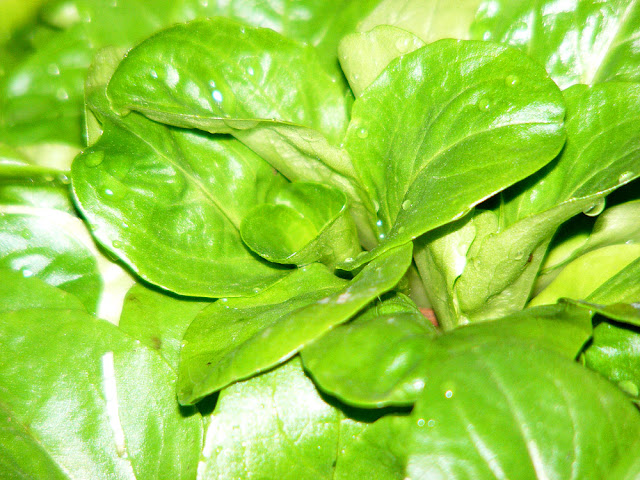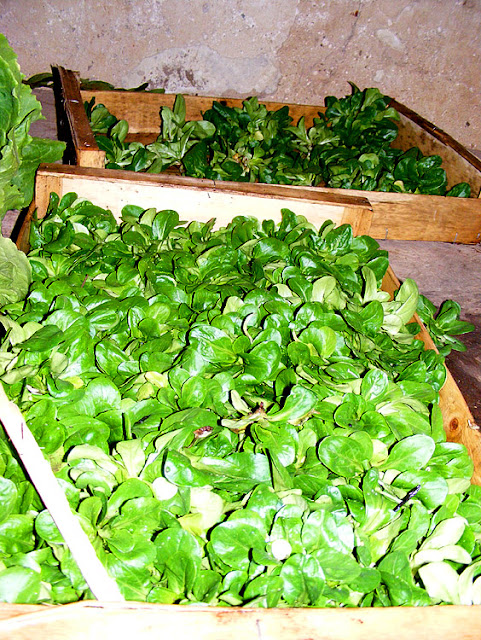In French the generic term for leafy salad greens is 'salade'. There are considered to be three main groups of salade -- mâche (lambs lettuce), laitue (lettuce), and chicorée (chicory). Mâche, or lambs lettuce, is a winter salad leaf vegetable, forming green rosettes of spoon shaped leaves and appearing at the markets from early November through to the end of February.
The parent plant is native to the Mediterranean basin, where it was gathered in the wild, and can be seen depicted in ancient Egyptian tomb paintings. It was first cultivated in France, on the banks of the Loire, in Renaissance times, and appears in paintings from that period.
 |
| A lambs lettuce rosette. |
Production today is still concentrated in the Pays de Loire (western Loire Valley around Nantes), with 85% of the annual national production of 20 000 tonnes coming from this area. France is the largest producer in the world, followed in Europe by Germany and Italy. 45% of the French production is exported to Britain, Spain and other countries.
Each French person consumes on average 4.5 kilograms of lettuce annually (mostly 'batavia', which includes varieties such as iceberg and merveille de quartre saisons, followed by other lettuce (eg cos/romaine), then oak leaf varieties; 2 kilograms of chicories (eg escarole, radicchio) and 150 grams of mâche.
 |
| Organic lambs lettuce for sale in the farm shop at Les Jardins Vergers de la Petite Rabaudière on the outskirts of Preuilly sur Claise. |
Lambs lettuce may be the least eaten, but it is gaining more and more of a following, due to better presentation in the market place (packaged neatly in punnets, for example, or ready washed in plastic bags) and after recent studies revealed just how nutritious it is, with high levels of Omega 3 fatty acids, Vitamin C, beta-carotenes and fibre. It's also low in calories and a good source of folic acid.
Lambs lettuce is a soft and delicate leaf, so although it needs washing before eating because it often has sand on it, don't leave it to soak and don't be too rough with it, or you will damage the leaves. Take the roots off before you wash it, to get rid of most of the sand. It will keep 3-4 days in the fridge if protected in a plastic bag or container.
Lambs lettuce is mostly eaten raw, and pairs well with beetroot, apples, goats cheese, Roquefort, hard boiled eggs and walnuts. Because the leaves are delicate, don't dress it until the last minute -- some walnut, olive or grapeseed oil is good, but go easy on the vinegar (choose cider, balsalmic or sherry vinegar). The flavour of lambs lettuce is delicately aromatic, sweet and a bit nutty.
 |
| Keel-fruited Cornsalad Valerianella locusta f. carinata (Fr. Doucette carénée) growing wild in the Courtineau Valley, near Sainte Maure de Touraine. |
The species of lambs lettuce that is cultivated is Valerianella locusta, and now there are more than a dozen cultivated varieties breed for extra succulence since the 18th century. As a wild plant it is an arable weed that thrives even in dry conditions. There are several species of Valerianella that occur in the wild in the Touraine Loire Valley, including V. locusta. As wild plants they are generally referred to as Doucette in French or cornsalad in English, rather than mâche or lambs lettuce, which seem to be reserved for the cultivated plant. All Valerianella species are edible.

3 comments:
" 85% of the annual national production of 20 000 tonnes coming from this area."
Jeeeezzzz, that's a lot of Lambs' Lettuce... every one of those veg fields along the Loire must be given over to its production!!
Of course, salade is much more than leafy greens. It could be endive, carrots, mushrooms, potatoes or tomatoes and even fruits.
chm: Whilst I hesitate to argue with a native speaker I would say yes and no. If you go to the market to buy lettuce that will be 'salade'. Then you might have on a menu 'Nos Salades', which are 'Salades Composées'. I would have said that salad ingredients are more likely to be referred to as 'crudités' in French.
Post a Comment